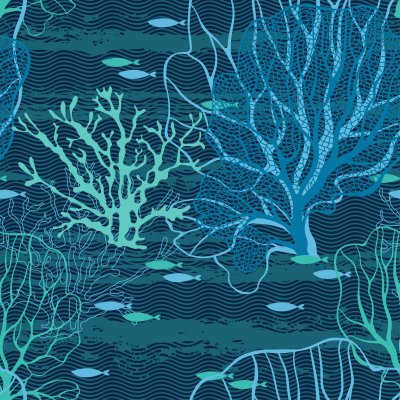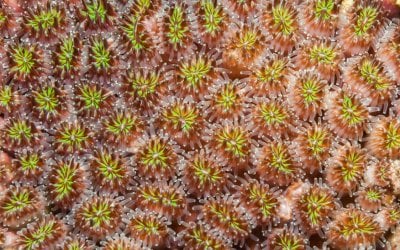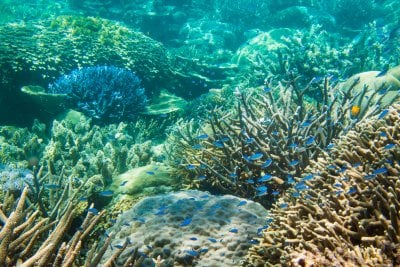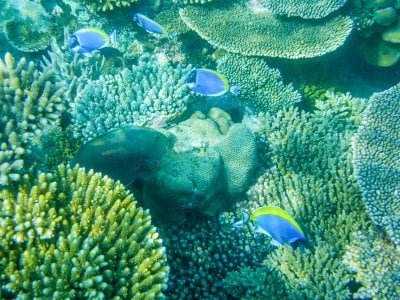All images used in this article were obtained legally, using istock photo.
Often the first few weeks after a new coral is introduced to the aquarium are the most crucial. It’s during this time that a coral must adjust to new lighting parameters, water chemistry and the host of variables that come with being introduced to an entirely new enviroment. Sometimes coral color degrades or sometimes a specimen fails to open. In worst case scenarios the aquarist is shocked to see rapid tissue narcosis (RTN) or a loss of tissue around the coral’s edges. For years, aquarists have sought ways to acclimate corals to the aquarium and avoid the pitfalls which are common when a new species is introduced. The goals are simple; maintain color, growth and overall health. Even seasoned reef keepers, whom have spent years refining their acclimation and introduction procedure, sometimes find a coral fails to adjust and withers away within a matter of weeks. These issues are so common; reef keepers describe some coral species as “hit or miss.” It’s hard to believe, with all the progress made within reef keeping, that some species would still allude our best efforts to ensure they thrive within the aquarium.
What if there was a way to help ensure new coral species acclimate easily to the aquarium, while maintaining their color, polyp extension and growth? What if doing this relied on tools an aquarist already had in their reef keeping arsenal? Is it possible to ensure a coral remains healthy during those first detrimental weeks?
An exciting study:
In 2015, the University of Miami Rosentiel School of Marine and Atmospheric Science set-out to learn what factors could improve coral’s resistance to climate change. Their focus was staghorn coral (Acropora cervicornis) which has nearly been eradicated throughout the Caribbean Sea. Climate change has played a large role in this mass die-off, presenting corals with a mix of rising ocean temperatures, high levels of co2 and dwindling ph. Researchers set-up two identical aquariums, both mirroring the effects of climate change. Water temperature was slowly increased and ph was slowly dropped by allowing co2 to build-up within the water.
One population of corals was heavily fed a diet of live rotifers and planktonic foods (the same preparations available to aquarists) while the other tank wasn’t fed anything, other than the excess food left over from zooxanthellae’s photosynthesis. The results were surprising. The corals within the tank which was fed the same foods available to all aquarists thrived, maintaining their color, polyp extension and growth, even in climate change conditions. Corals within the tank not supplemented with foods began to bleach, retract and eventually succumbed to RNT, which is a common symptom of climate change on coral reefs. The researchers used mixed genetic strains of staghorn coral, helping to ensure that the study wasn’t a fluke, with one genetic strain being more resistant to climate change than the others.
Is feeding really that effective?
It’s important to understand that not every reef aquarist feeds their corals. Even without feeding, many are able to maintain beautiful reef tanks. Reasons for not feeding are varied; some aquarists feel it will foul water quality, while others see good results without the extra expense and work. In the early days of reef keeping feeding had sparse popularity and only recently have commercial coral diets boomed in popularity. Early coral diets consisted of yeast and freeze dried plankton mixes. A study done in Hawaii years ago, showed that of several commercial coral diets, only two produced measurable results (BRS’ coral chili and Polyp Lab’s Reef Roids). Today, the market for coral foods has opened the doors to natural foods, such as Reef Nutrition’s Phytofeast, ROE and Oyster Feast. Live rotifers and phytoplankton can easily be purchased, stored and fed on a regular basis. It gives aquarist the opportunity to feed corals natural foods easily and quickly. For a while now, we’ve heard various reef aquarists rave about the benefits of feeding, but nothing concrete has studied these effects in a manner that leads to research published in a scientific journal.
University of Miami’s study changes that, as they’ve published a paper entitled Threatened Caribbean coral is able to mitigate the adverse effects of ocean acidification on calcification by increasing feeding rate.
So how does feeding mitigate the negative effects of stress and improper water conditions? One of the biggest concerns when keeping corals is that they will expel their zooxanthellae algae. In the aquarium, this can happen because nutrients within the water accelerate zooxanthellae growth, causing the coral to see the algae as a threat and expel them, almost like an immune response. Unstable water conditions can cause the same thing, as can the stress of being picked at by fish. Once zooxanthellae are expelled, the coral is left without a food source, meaning they no longer have a way to produce the energy needed to expand and grow.
Researchers found that feeding gives the corals a back-up way to build caloric energy. The nutrition provided during feeding goes directly to the coral colony and isn’t simply passed on by zooxanthellae. This energy can be directly put to use in building skeleton and maintaining healthy tissue. It may also be able to aid the coral in mitigating the effects of higher nutrients and perhaps the coral can maintain vitality, even when zooxanthellae are growing faster than usual. For corals, feeding truly acts as a supplement. If they aren’t getting enough food passed down from zooxanthellae in their tissues, feeding can make up the difference. Conversely, if conditions are right and zooxanthellae is aiding the colony, feeding can give them an extra bit of protection against a changing environment.
It's quite possible that feeding can aid aquarists in mitigating low or high levels of light, incorrect calcium, carbonate and magnesium concentration, on down to fluctuating ph.
Some advice on feeding:
It’s important that aquarists ensure two things: one, that they’re feeding a nutritious and appropriate diet and two, that they’re feeding the right amount, at correct intervals. Being sedimentary animals, corals don’t need fed multiple times per day like fish, or even mobile invertebrates. Feeding two to three times per week often works best and overfeeding a coral can be just as detrimental to health as under-feeding. I caution aquarists against freeze dried powder foods, simply because some of them are known to be primarily yeast and it’s impossible for aquarists to verify the food’s contents. Often the label is sparse, simply reading Planktonic coral food. Natural foods however are clearly the advertised product and can easily be identified once they hit the water. Also, both Reef Chili and Reed Roids have been used in studies, so they are both good choices.
Often the first few weeks after a new coral is introduced to the aquarium are the most crucial. It’s during this time that a coral must adjust to new lighting parameters, water chemistry and the host of variables that come with being introduced to an entirely new enviroment. Sometimes coral color degrades or sometimes a specimen fails to open. In worst case scenarios the aquarist is shocked to see rapid tissue narcosis (RTN) or a loss of tissue around the coral’s edges. For years, aquarists have sought ways to acclimate corals to the aquarium and avoid the pitfalls which are common when a new species is introduced. The goals are simple; maintain color, growth and overall health. Even seasoned reef keepers, whom have spent years refining their acclimation and introduction procedure, sometimes find a coral fails to adjust and withers away within a matter of weeks. These issues are so common; reef keepers describe some coral species as “hit or miss.” It’s hard to believe, with all the progress made within reef keeping, that some species would still allude our best efforts to ensure they thrive within the aquarium.
What if there was a way to help ensure new coral species acclimate easily to the aquarium, while maintaining their color, polyp extension and growth? What if doing this relied on tools an aquarist already had in their reef keeping arsenal? Is it possible to ensure a coral remains healthy during those first detrimental weeks?
An exciting study:
In 2015, the University of Miami Rosentiel School of Marine and Atmospheric Science set-out to learn what factors could improve coral’s resistance to climate change. Their focus was staghorn coral (Acropora cervicornis) which has nearly been eradicated throughout the Caribbean Sea. Climate change has played a large role in this mass die-off, presenting corals with a mix of rising ocean temperatures, high levels of co2 and dwindling ph. Researchers set-up two identical aquariums, both mirroring the effects of climate change. Water temperature was slowly increased and ph was slowly dropped by allowing co2 to build-up within the water.
One population of corals was heavily fed a diet of live rotifers and planktonic foods (the same preparations available to aquarists) while the other tank wasn’t fed anything, other than the excess food left over from zooxanthellae’s photosynthesis. The results were surprising. The corals within the tank which was fed the same foods available to all aquarists thrived, maintaining their color, polyp extension and growth, even in climate change conditions. Corals within the tank not supplemented with foods began to bleach, retract and eventually succumbed to RNT, which is a common symptom of climate change on coral reefs. The researchers used mixed genetic strains of staghorn coral, helping to ensure that the study wasn’t a fluke, with one genetic strain being more resistant to climate change than the others.
Is feeding really that effective?
It’s important to understand that not every reef aquarist feeds their corals. Even without feeding, many are able to maintain beautiful reef tanks. Reasons for not feeding are varied; some aquarists feel it will foul water quality, while others see good results without the extra expense and work. In the early days of reef keeping feeding had sparse popularity and only recently have commercial coral diets boomed in popularity. Early coral diets consisted of yeast and freeze dried plankton mixes. A study done in Hawaii years ago, showed that of several commercial coral diets, only two produced measurable results (BRS’ coral chili and Polyp Lab’s Reef Roids). Today, the market for coral foods has opened the doors to natural foods, such as Reef Nutrition’s Phytofeast, ROE and Oyster Feast. Live rotifers and phytoplankton can easily be purchased, stored and fed on a regular basis. It gives aquarist the opportunity to feed corals natural foods easily and quickly. For a while now, we’ve heard various reef aquarists rave about the benefits of feeding, but nothing concrete has studied these effects in a manner that leads to research published in a scientific journal.
University of Miami’s study changes that, as they’ve published a paper entitled Threatened Caribbean coral is able to mitigate the adverse effects of ocean acidification on calcification by increasing feeding rate.
So how does feeding mitigate the negative effects of stress and improper water conditions? One of the biggest concerns when keeping corals is that they will expel their zooxanthellae algae. In the aquarium, this can happen because nutrients within the water accelerate zooxanthellae growth, causing the coral to see the algae as a threat and expel them, almost like an immune response. Unstable water conditions can cause the same thing, as can the stress of being picked at by fish. Once zooxanthellae are expelled, the coral is left without a food source, meaning they no longer have a way to produce the energy needed to expand and grow.
Researchers found that feeding gives the corals a back-up way to build caloric energy. The nutrition provided during feeding goes directly to the coral colony and isn’t simply passed on by zooxanthellae. This energy can be directly put to use in building skeleton and maintaining healthy tissue. It may also be able to aid the coral in mitigating the effects of higher nutrients and perhaps the coral can maintain vitality, even when zooxanthellae are growing faster than usual. For corals, feeding truly acts as a supplement. If they aren’t getting enough food passed down from zooxanthellae in their tissues, feeding can make up the difference. Conversely, if conditions are right and zooxanthellae is aiding the colony, feeding can give them an extra bit of protection against a changing environment.
It's quite possible that feeding can aid aquarists in mitigating low or high levels of light, incorrect calcium, carbonate and magnesium concentration, on down to fluctuating ph.
Some advice on feeding:
It’s important that aquarists ensure two things: one, that they’re feeding a nutritious and appropriate diet and two, that they’re feeding the right amount, at correct intervals. Being sedimentary animals, corals don’t need fed multiple times per day like fish, or even mobile invertebrates. Feeding two to three times per week often works best and overfeeding a coral can be just as detrimental to health as under-feeding. I caution aquarists against freeze dried powder foods, simply because some of them are known to be primarily yeast and it’s impossible for aquarists to verify the food’s contents. Often the label is sparse, simply reading Planktonic coral food. Natural foods however are clearly the advertised product and can easily be identified once they hit the water. Also, both Reef Chili and Reed Roids have been used in studies, so they are both good choices.


















